The cable tricep pushdown is a versatile isolation exercise that you can perform with a wide variety of attachments and grips.
The cable rope pushdown is the most popular variation because using a rope enables you to achieve a stronger peak contraction, especially in the long head of the triceps.
But despite the effectiveness of the rope tricep pressdown, many lifters still get suboptimal results because they train with the improper form and let their other muscles take over, which robs the triceps of tension.
So to keep you firmly on the path to optimal triceps development, you’ll learn how to do a tricep pushdown the right way and then discover the most common lifting mistakes that you need to avoid in order to get the best results.
Standing cable tricep pushdown exercise details
- Also Known As: Rope tricep press down, cable tricep pull downs
- Main Muscles: Triceps
- Exercise Type: Strength
- Exercise Mechanics: Isolation
- Difficulty Level: Beginner
- Equipment Needed: Cable station, rope attachment
How to do tricep pushdowns
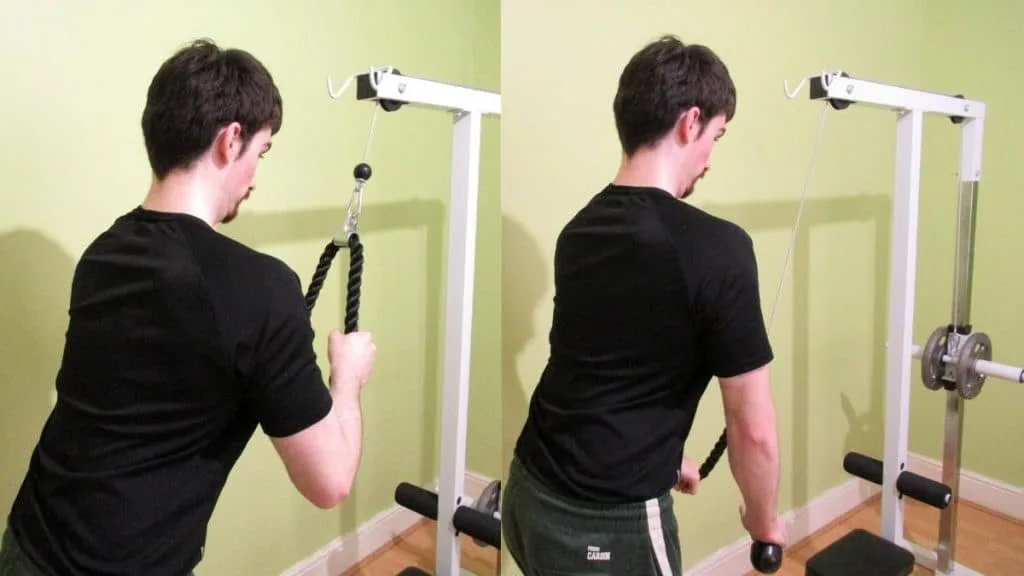
- Connect a rope attachment to a high pulley.
- Grab the lower portion of the rope with a firm grip.
- Take a couple of small steps away from the machine.
- Stick your chest out and push your hips back slightly so that you’re not standing completely upright (this increases the range of motion).
- Pin your elbows to your sides and tighten your core.
- Flex your triceps to push the rope down.
- Spread the ends of the rope (by moving them away from each other) as your elbows reach full extension.
- Flex your triceps forcefully and then slowly release the contraction while ensuring that your elbows don’t drift forward.
- Resist the tension until the rope is at chest height (when your forearms press up against your biceps).
- Repeat for 3-5 sets of 8-15 reps.
Cable triceps pushdown mistakes
To avoid unnecessary injuries and get the most from cable tricep pulldowns, it’s vital that you steer well clear of these 7 pulley pushdown mistakes, some of which you might not even realize that you’re making.
Standing too close to the pulley
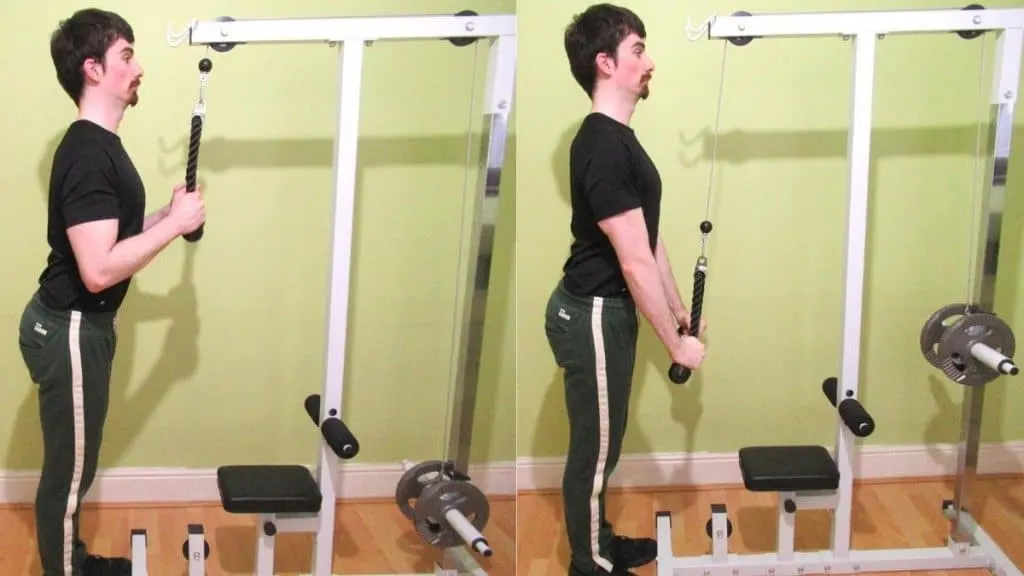
Standing too close to the pulley during triceps rope pushdowns is actually the least severe mistake because it’s a body positioning error rather than a flaw in your lifting technique.
Still, when you stand too close to the pulley, you often limit your range of motion (and thereby your triceps activation) while reducing the potency of the peak contraction. This is because when you lock your elbows out while standing right next to the machine, the tension is just going through your joints since the force of the pulley is traveling straight down.
Yet, when you take a few steps back, the cables are no longer traveling straight up and down; they’re moving diagonally. As such, when you lock your elbows out now, your triceps naturally receive more stimulation because they have to contract harder in order to resist the tension of the pulley.
Similarly, standing too far away from the machine during a cable tricep push down can make it difficult to use the proper form because the pulley is always trying to drag your arms forward and out of position.
As you’ll learn later, letting your elbows drift forward brings your lats into the movement, which in turn means that your triceps receive less tension since they’re now doing less work.
Standing too far away from the machine also places a greater demand on your core strength because your abs have to contract intensely to prevent your body from getting dragged forward by the force of the pulley. Having to flex your abs so hard and for so long can impair your ability to train your triceps, which ultimately defeats the purpose of this isolation exercise.
Flexing your wrists
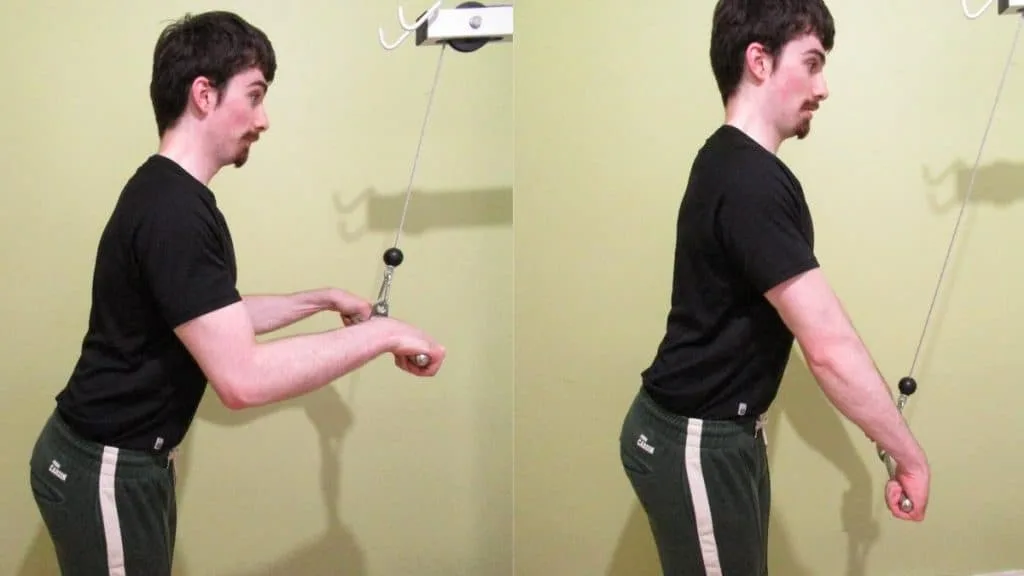
Flexing your wrists at the bottom of the rep is the most sinister cable press down mistake that you can make. This is because it tricks you into thinking that you’re achieving a good triceps contraction when, in reality, the wrist flexion just compensates for the lack of elbow extension.
You always want to achieve full elbow extension because locking out the elbows is the primary function of the triceps.
Thankfully, you can easily remedy this problem by keeping your wrists straight and using a tricep rope rather than a bar attachment (see our tricep pushdown rope vs bar comparison for more info).
Picturing your triceps contracting as your elbows reach full extension can also help to minimize forearm involvement by strengthening your mind-muscle connection.
Improving your mind-muscle connection enables you to achieve more triceps growth without increasing the resistance. This is because even though you’re not subjecting them to heavier weights, your triceps will be doing more work when you know how to stretch and contract them properly.
Turning it into a press
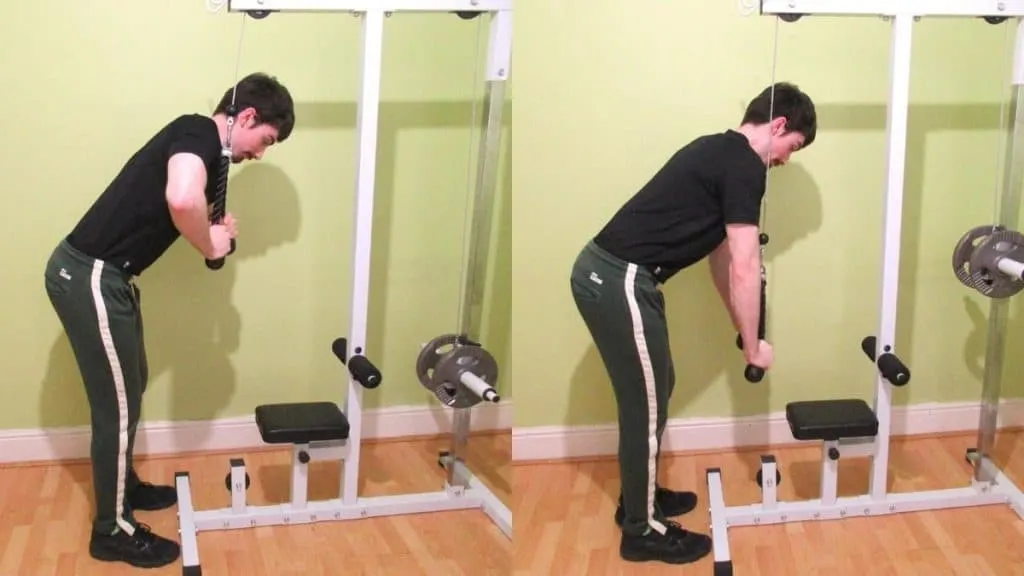
If you want to keep your shoulders safe and your triceps growing, don’t turn the rope triceps pushdown into a multi-joint compound press.
This is one of the most common technique mistakes that you see in the gym, and it’s also one of the most fatal for your triceps development.
The main culprits for turning your pushdown into a press are the weight stack (which is to say lifting too heavy) and fatigue.
You know that you’re lifting too much weight when your elbows flare out and your shoulders round forward, which, as noted, can happen due to ego lifting or your overeagerness to train past triceps muscular failure.
Even though you can push heavier poundages when you bring your chest and delts into the movement, your triceps aren’t actually receiving any more tension (in fact, they’re likely receiving considerably less tension than usual) because the extra resistance is just going to the muscles that you’re using to cheat.
Instead, do this: Retract your scapula, stick your chest out, and keep your elbows pinned to your sides.
With textbook form like this, your cable tricep press down will remain a single-joint, isolation exercise—one which will keep your elbows and shoulders safe while ensuring that your triceps get the attention they deserve. After all, the triceps account for two-thirds of your upper arm size. More on that later.
Avoiding complete lockout

As mentioned earlier, locking the elbows out is the primary function of the triceps. So by avoiding complete elbow extension, you’re also avoiding—intentionally or not—maximum triceps development.
But what about constant tension? Doesn’t stopping just shy of lockout during pushdowns produce a better triceps pump?
Sure it does. But the pump isn’t the primary catalyst for muscle growth; mechanical tension is the main driver of hypertrophy. [1]
And besides, if you perform enough reps and sets with good form, then you’re going to get a tremendous triceps pump regardless of whether you lock your elbows out or not. So try not to obsess over the pump at the expense of muscle-building fundamentals like progressive overload.
Splitting the rope at the end of each rep ensures that you’re achieving full elbow extension and thus maximizing the effectiveness of the tricep rope press down. Since achieving complete elbow extension results in a powerful peak contraction, splitting the rope also creates a potent pump in your triceps.
Allowing too much elbow movement
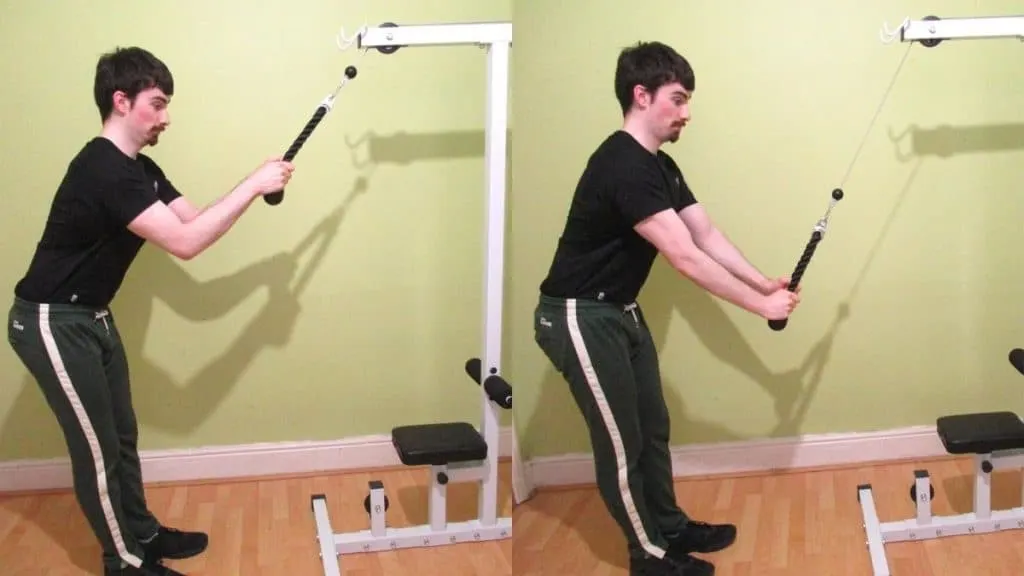
Technically, it’s not incorrect to allow a moderate amount of elbow movement during cable pushdowns because moving your elbows forward and then back again increases activation of the long head, which is the biggest head of the triceps.
But just because the long head is the largest tricep muscle doesn’t mean that you have to train it during every exercise; the lateral and medial heads need work as well.
In fact, when you limit the long head’s involvement in the exercise by keeping your elbows still, the other two heads naturally contribute more force during the movement, which naturally means that they also receive more muscle-building tension.
To be clear, you can’t take the long head out of the movement completely because it still performs elbow extension like the lateral and medial heads. But because the long head is the only triceps muscle that acts on the shoulder, you can reduce its activation by keeping your elbows stationary (which means that your shoulders won’t move around).
Limiting movement to the elbow joint has the added benefit of ensuring that your lats don’t take over the exercise.
This is because the lats are an even more powerful shoulder extensor than the long head of the triceps. [2] So by keeping your shoulders still, your lats can’t contribute any force toward the movement, which naturally means that the triceps have to do all of the lifting, which is the exact purpose of tricep cable press downs.
Not controlling the eccentric
The peak contraction is the most tangible part of a triceps cable push down rep because you can feel the triceps contracting as your elbows reach full extension.
Yet, the eccentric phase of the pushdown rep is equally, if not more crucial than the concentric portion of the rep for stimulating triceps hypertrophy. This is because when you control the eccentric part of the rep, your triceps get plenty of growth-stimulating time under tension, which in turn leads to muscle fiber breakdown, which is the starting point of hypertrophy.
It’s crucial to keep your elbows pinned to your sides during the eccentric phase of the rope push down so that your triceps have to resist the tension. In other words, all of the movement should occur at the elbow joint and not at the shoulder, in which case you’d risk the lats taking over the exercise.
Controlling the eccentric phase of the rep is very tricky if you’re standing too far away from the machine because the force of the pulley is always trying to pull your arms forward and out of position.
So take heed of my earlier advice: Take only a few small steps away from the pulley. You want enough space between yourself and the machine to provide an extensive range of motion but not so much distance that you’re constantly fighting against the force of the cables.
Using the wrong rep range
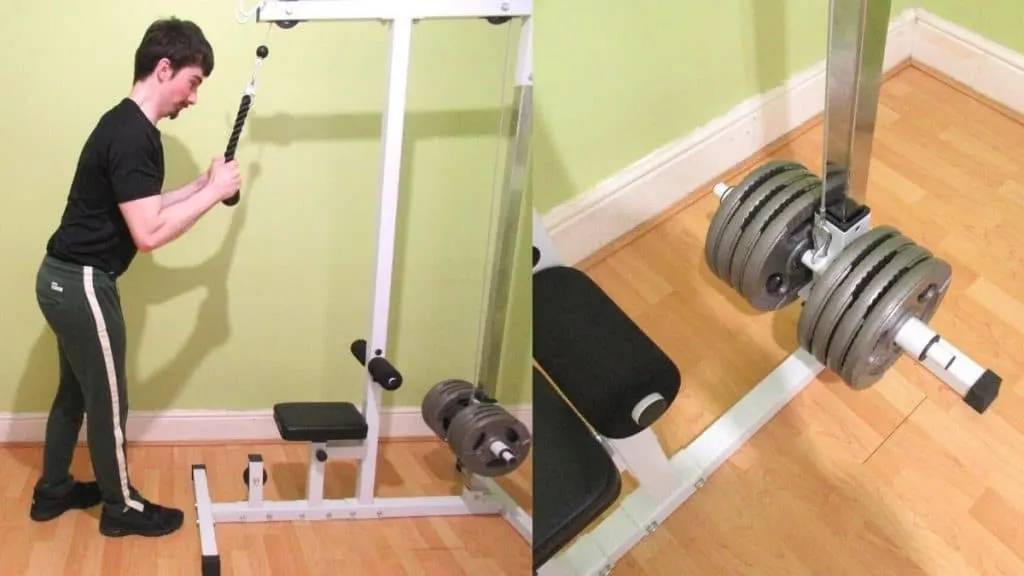
While it’s technically possible to do low rep rope tricep pull downs, lifting too heavy commonly leads to a breakdown in form.
For this reason, most lifters are best off sticking to moderate or high repetitions (10-15).
Lightening the resistance and increasing your reps enables you to establish a stronger mind-muscle connection with your triceps and ensures that your elbows don’t take too much of a beating (a problem with many single-joint tricep exercises).
Even though the triceps is a fast-twitch muscle, meaning that it naturally responds well to low reps, it’s best to reserve the really heavy lifting for your compound presses, where you can really load up on the resistance.
Of course, you still want to increase the tricep pushdown resistance where possible. But since single-joint exercises like pulley pushdowns rely on strict form to remain effective, it’s critical that you don’t sacrifice your technique in order to lift heavier weights.
Tricep pushdown variations
There are more than 10 different cable tricep pressdown variations that you can do for your triceps.
We covered the 6 most popular versions in the following section, but you can find full tutorials for every tricep pushdown variation via the links below.
- EZ bar pushdown
- Isometric triceps pushdown
- Kneeling tricep pushdown
- One arm reverse pushdown
- Rocking tricep pushdown
- Stability ball tricep pushdown
- Close grip pushdown
- Wide grip tricep pushdown
- Drag pushdown
- Tricep pushdown on the assisted pull up machine
One arm tricep rope pushdown

The cable one arm triceps extension helps you to develop symmetrical upper arms by ensuring that both of your triceps receive similar amounts of work.
You can do this tricep pushdown exercise with a single handle, single rope, or with no attachment at all, so it’s not like you need any fancy equipment to get the symmetry benefits.
Of course, training one arm at a time will make your workouts that bit longer. But if you already have decent triceps development and want to take your upper arm aesthetics to the next level, then the symmetry gains will definitely be worth the extra time in the gym.
Building symmetrical triceps helps your upper body to look more proportional, something which is of paramount importance if you’re a competitive physique athlete or someone who trains primarily for aesthetics.
Straight bar triceps cable pushdowns
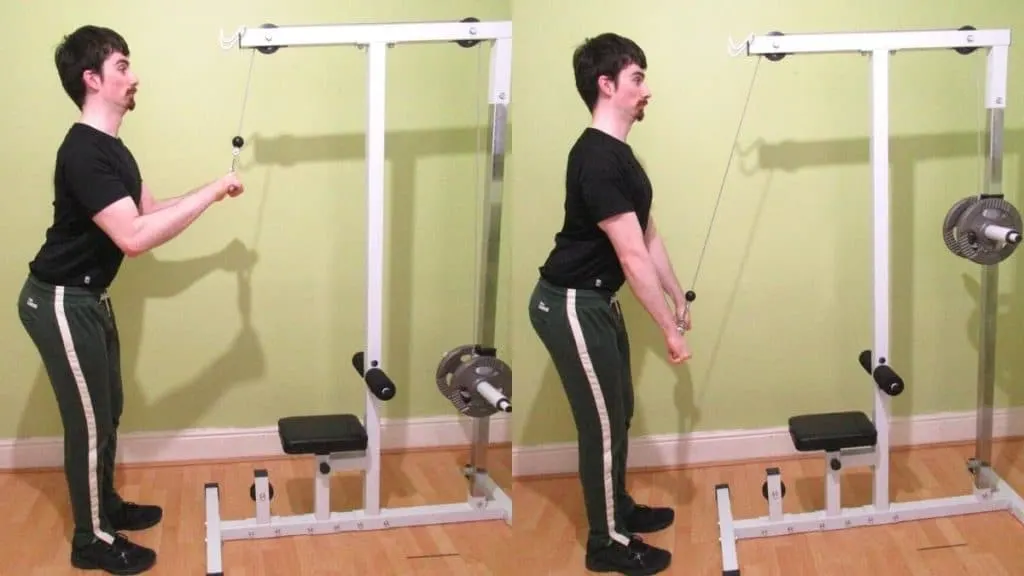
Straight bar pushdowns enable you to lift heavier than the rope pushdown exercise. This is simply because it’s easier to balance one bar attachment than it is to stabilize two separate sides of a triceps rope.
The trade-off of being able to push heavier poundages is that the straight bar pushdown is more likely to hurt your wrists and lead to muscular imbalances.
Using a straight bar forces your hands into an extreme amount of pronation, which can often lead to wrist pain when the weight gets heavy.
With tricep rope pressdowns, on the other hand, your wrists are in a neutral position, which puts far less (if any) pressure on your joints, which in turn means that you can better focus on training your triceps.
As mentioned, using a straight bar for a standing tricep pushdown can also lead to tricep size asymmetries because your stronger side can easily dominate the movement when you’re lifting the same attachment with both arms.
With tricep rope pushdowns, however, you get to lock each side of the rope out independently, which means that both of your triceps get similar amounts of stimulation.
V bar tricep cable pushdown
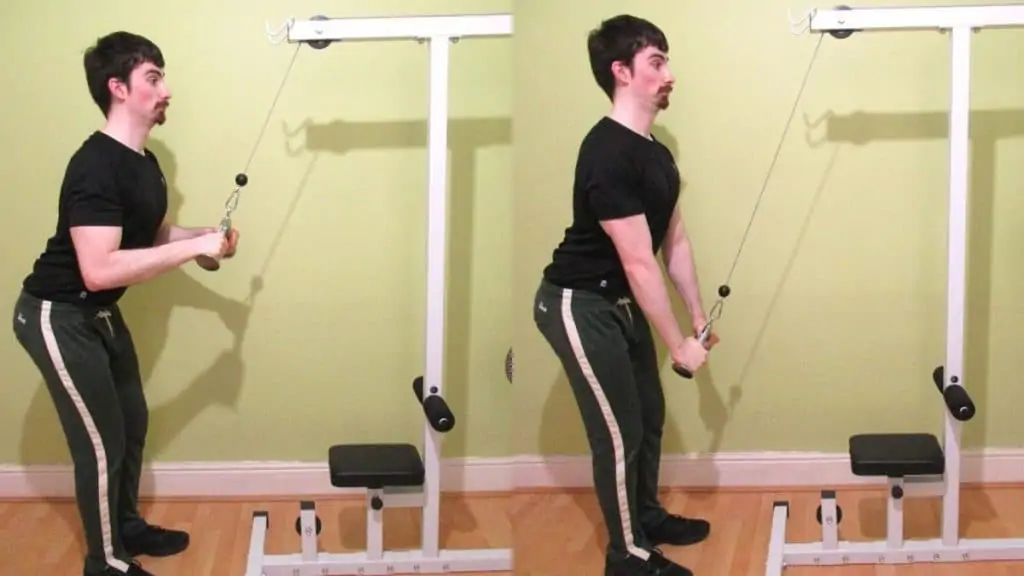
The v bar pushdown is one of the most popular types of cable pressdowns because, as mentioned, bar attachments enable you to lift more weight than ropes, thus allowing you to overload your triceps with extra resistance.
The v-bar is more joint-friendly than the straight bar, however, because it places your wrists into a more comfortable semi-pronated position rather than forcing your wrists into maximum pronation.
Since v-bars are typically a very narrow attachment, the v-bar pushdown is naturally a great pressdown exercise for maintaining the proper form because it encourages you to keep your elbows pinned to your sides.
Keeping your elbows close to your sides, in turn, ensures that your triceps (and not your lats, chest, and shoulders) are performing the vast majority of the heavy lifting. As such, the v bar pressdown is an excellent rope tricep pushdown alternative for those who don’t have access to a triceps rope.
Reverse grip tricep cable pressdown
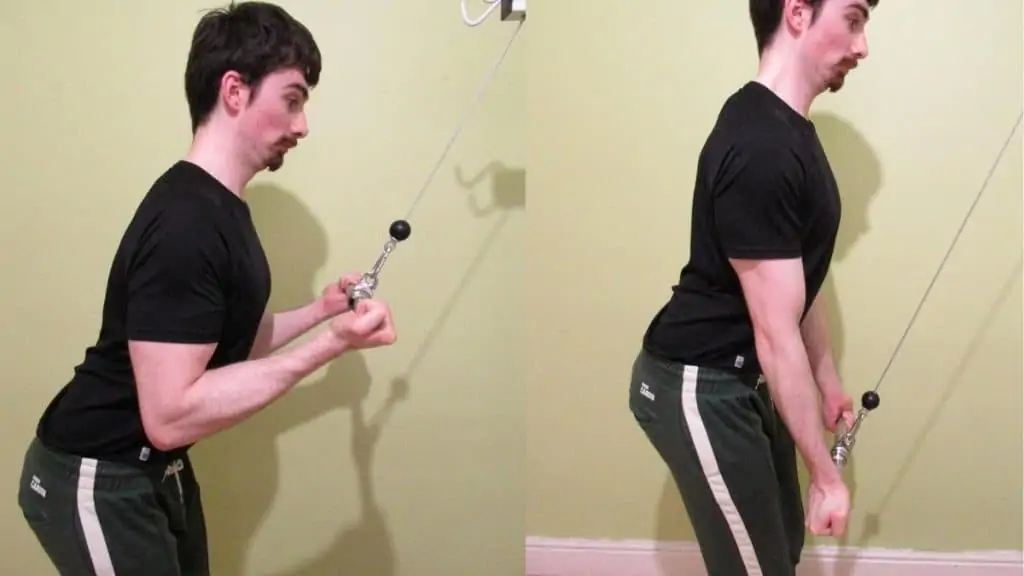
Many coaches correctly point out that your wrist position doesn’t theoretically influence your triceps activation in any way.
This is because, besides the long head, which also acts on the shoulder joint, the only function of the triceps is elbow extension, and this isn’t affected by your wrist position.
But notice how I said theoretically. When you perform a rope triceps pressdown with an underhand grip, your elbows will still have a tendency to move closer to your sides because the body doesn’t perform movements in isolation.
In other words, during practical scenarios in the gym, wrist movement almost always leads to shoulder movement. [3] Specifically, a supinated wrist position results in external rotation at the shoulder joint, which is why your elbows naturally stay pinned to your sides when you do a reverse grip tricep pushdown.
Banded tricep pull down
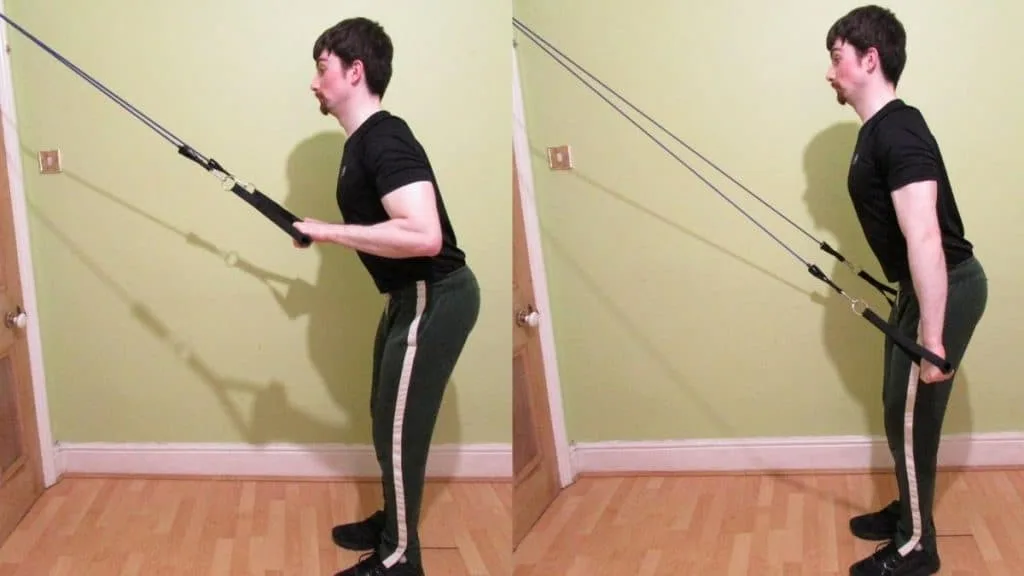
If you’re training at home and/or don’t have access to a cable machine, then you can do a resistance band tricep pushdown instead of a tricep cable press down.
You’ll still be lifting with the same tricep pushdown form when you use a resistance band, so you won’t need to learn a completely new press down exercise. In fact, the only difference is that while bands do provide constant tension, they don’t offer consistent tension in the way that cables do.
As such, the lockout phase of the rep is always the hardest part of a band pushdown because that’s the part of the rep when the band provides the most resistance due to it being highly stretched.
Stepping away from the anchor point of the band will ensure that your triceps are under tension from the very first inch of movement.
However, it won’t completely smooth out the tension because, as a simple rubber band, your resistance band will still get heavier the more that it’s stretched, which means that the lockout phase of the rep will always remain highly challenging (which is great for getting a pump).
Seated tricep pulldown
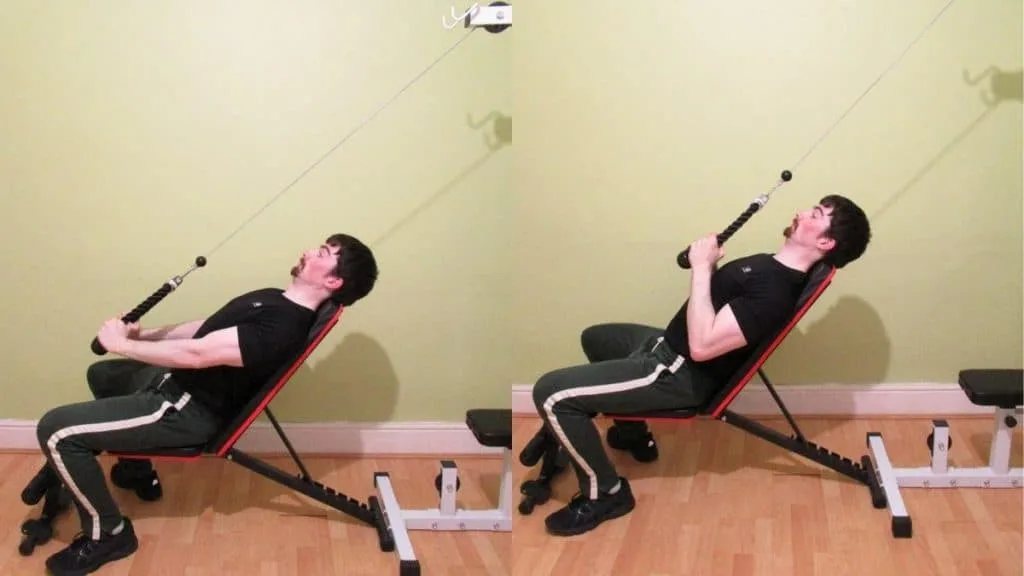
You can perform the seated tricep pushdown in two ways: on an incline bench or on a flat bench.
With the incline bench version, the cable is coming from behind you, and your shoulders are in a higher degree of flexion than usual, which means that the long head of your triceps naturally gets a better workout (only the long head acts on the shoulder joint, remember?).
You can also do regular triceps pressdowns while sitting on a flat bench in order to eliminate momentum from the movement. This option is particularly useful if you often struggle to maintain the proper tricep pushdown form because you can’t generate momentum with your legs and hips when you’re sitting down.
Cable rope tricep pushdown benefits
Performing a pressdown workout always gets your triceps pumped and on their way to growing bigger.
This section explains why rope press downs are so effective for stimulating triceps hypertrophy so that you can gain a deeper understanding of the benefits of tricep pushdowns.
Bigger triceps
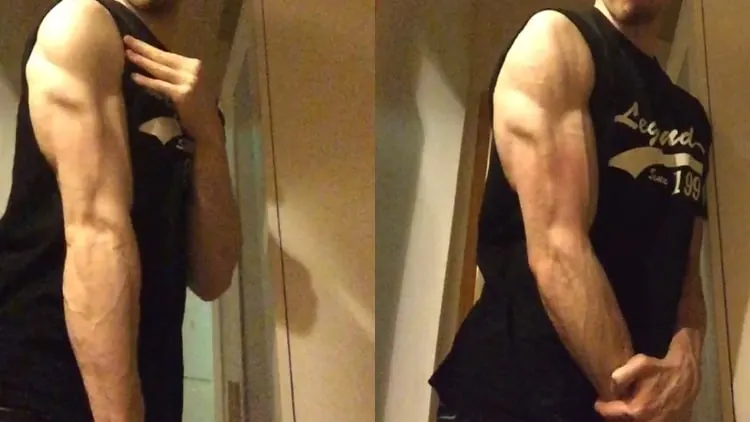
Many lifters obsess over the long head of the triceps because it’s the biggest triceps muscle and thus the most critical head for gaining size.
Yet, there’s no need to train the long head optimally in every exercise that you perform; the medial and lateral heads still require plenty of work if you want to achieve optimal triceps development.
Since the triceps cable pushdown is a pure elbow extension exercise, it doesn’t put the long head under much of a stretch (which would require you to put your arms over your head). [4] This reduced long head activation might seem like a bad thing, but it’s actually great news for our purposes because it means that the lateral and medial heads have to do more work.
Of course, the long head still receives some stimulation because it’s an elbow extensor as well as a shoulder extensor. However, it won’t dominate the movement at the expense of the lateral and medial heads, which is often the case with overhead extensions and skull crushers.
While performing a cable rope press down doesn’t really stretch the long head, it actually gives you a good chance to achieve a strong contraction in the long head because you can split the ends of the rope to intensify the peak contraction.
This happens because the long head of the triceps acts on the shoulder joint. And so, when you split the ends of the rope, your shoulders naturally move backward slightly (into extension), which in turn forces the long head to contract harder.
More upper arm size
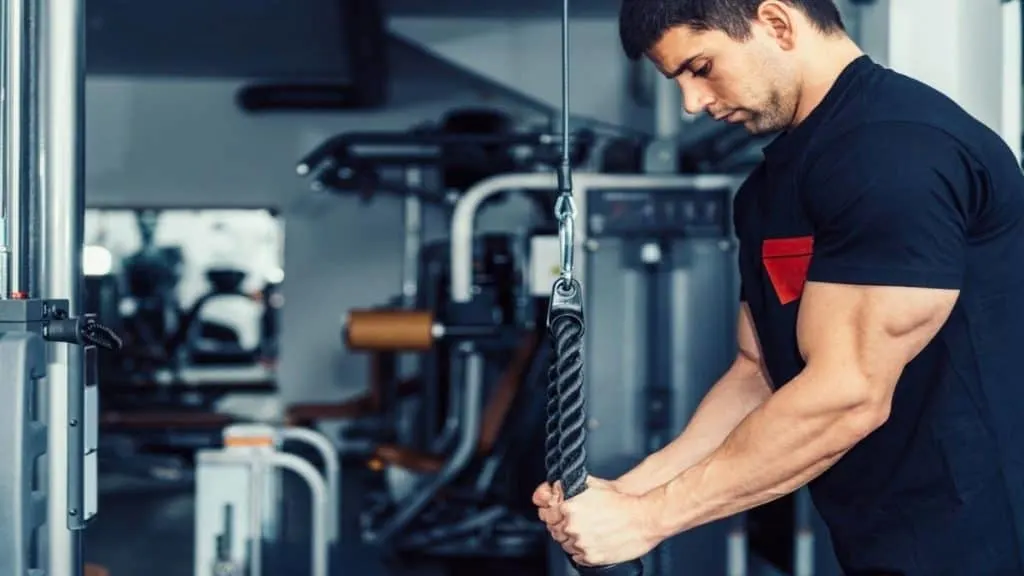
Since the triceps make up two-thirds of your upper arm size, any exercise that isolates the triceps naturally has excellent muscle-building potential.
This is why performing a regular pushdown workout can lead to a noticeable improvement in triceps size, strength, and definition—pushdowns are a pure tricep exercise.
So if your arms are lagging or if you just want to fill your sleeves, it always makes sense to prioritize your triceps more than your biceps, seen as the triceps are the larger muscle group by far.
Improving your arms by performing rope tricep pushdowns will help you to develop a powerful upper body and a more formidable physique because the arms are one of the most visible body parts (and it’s always the one that people ask you to flex).
Stronger compound presses
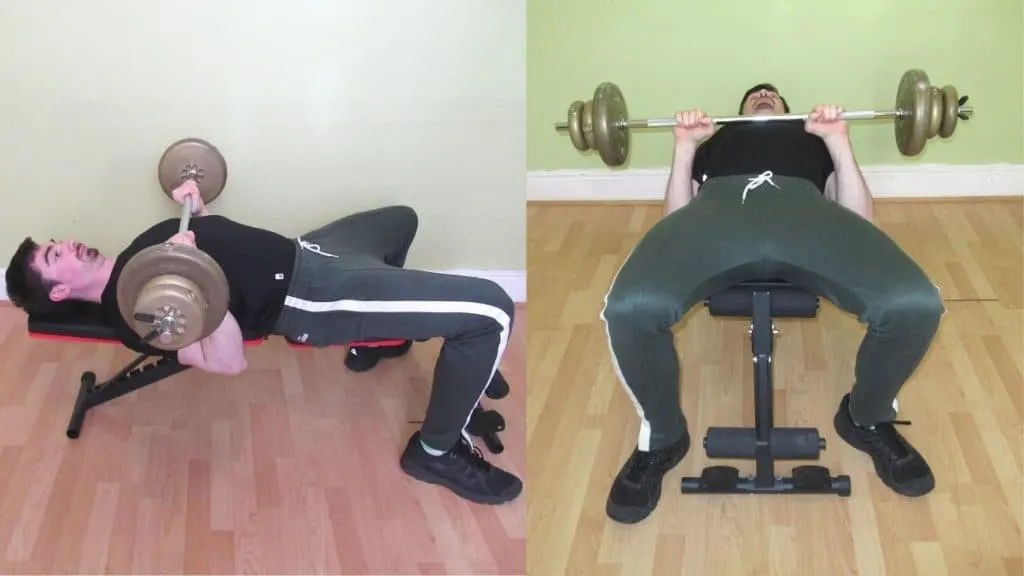
One thing’s for sure, having larger triceps is never going to hurt your pressing power; bigger triceps are only ever going to increase your pressing strength.
While triceps press downs might not have as much carryover to your bench press as free weight isolation exercises, they still boost your pressing power because a pushdown is essentially an elbow lockout performed with nothing other than the triceps.
And which muscle group is most responsible for the lockout phase of a bench press or overhead press rep?
The triceps.
So if you want to improve your lockout strength, triceps press-downs are one of the best exercises for the job because they get the triceps accustomed to locking out heavy weights.
Cable tricep pressdown FAQ
Learn more about the cable tricep pushdown with this detailed FAQ.
What is a tricep pushdown?
A tricep pushdown, also called a tricep pressdown, is an isolation exercise that weight lifters perform to strengthen their triceps. The movement is typically performed on a cable machine with a rope attachment, but both v-bars and straight bars are also commonly used.
The tricep cable pushdown requires the use of strict form in order to train the target muscles effectively because a pushdown is a single joint exercise.
Weight lifting enthusiasts commonly allow their lats and shoulders to take over the movement by letting their elbows drift forward. This mistake most often occurs when the trainee is lifting excessively heavy weights or when they haven’t yet taken the time to learn the proper tricep pressdown form.
What muscles does a tricep pushdown work?
The cable rope pushdown works all three heads of the triceps brachii muscle, namely, the long head, the lateral head, and the medial head.
Because cable rope pushdowns don’t train the long head in its optimal force-producing position (which is to say, when your arms are above your head and thus in flexion), tricep pushdowns are especially effective for training the lateral and medial heads of the triceps brachii muscle.
The abdominals are also active during a rope triceps pressdown because they have to contract isometrically in order to keep your torso stable so that your body doesn’t get pulled toward the machine by the force of the pulley.
Which attachments should you use for the triceps pressdown?
The pushdowns exercise is compatible with just about any attachment that you can connect to a cable machine.
Most lifters, however, gravitate toward the triceps rope pressdown because using a rope enables them to achieve a stronger peak contraction in their triceps.
In addition to performing a triceps pushdown with a rope, you can also do a pushdown using a bar attachment if you want to lift more weight.
Although both the v-bar and the straight bar will enable you to lift more resistance than the rope, your triceps won’t necessarily receive any more tension when you use a bar because the rope attachment provides more range of motion and a stronger peak contraction.
Straight bars are also notorious for causing wrist discomfort because they force your hands into extreme amounts of pronation. So for the best press down workout possible, your best bet is to stick with the triceps rope pushdown because the rope attachment enables you to keep your wrists in a neutral position.
How many cable rope pressdown reps and sets should you do?
The optimal number of tricep rope pressdown sets and reps depends on your level of advancement, recovery capabilities, and training goals.
That said, most lifters should perform around 3-5 sets of 10-15 reps of tricep pushdowns per workout.
The more advanced that your triceps are in terms of their development, the more training volume (i.e., sets) they can handle.
Likewise, those with good recovery capabilities (i.e., not in a large calorie deficit and able to get enough sleep) can also handle more training volume.
Since triceps cable pull downs don’t put the triceps under as much of a stretch as the likes of overhead extensions, they also cause less muscle damage and are thus easier to recover from, which means that you can get away with performing more sets.
Conclusion: Should you do triceps pushdowns?

The cable tricep pushdown is an excellent exercise for both beginner lifters and advanced strength trainees because it’s completely scalable to your ability level.
Cable weight stacks typically ascend in very manageable increments, so you’ll always have resistance that’s appropriate for the strength of your triceps.
The fact that you can do cable tricep pushdowns with a wide variety of attachments also makes the movement remarkably accessible because you’re never tied down to one particular training tool.
The triceps pressdown exercise is also easy to learn because, unlike with compound exercises, the movement only occurs at one joint, namely, your elbow. The straightforward lifting technique means that you can master the form quicker, which in turn enables you to gain strength (and thereby muscle) at a faster rate.
References
- Yandenburgh, H. H. (1987). Motion into mass. Medicine & Science in Sports & Exercise, 19 (Supplement), 142–149. https://doi.org/10.1249/00005768-198710001-00008
- Asher, A. (2019, August 7). What Does Your Latissimus Dorsi Do? Verywell Health. https://www.verywellhealth.com/latissimus-dorsi-muscle-anatomy-297067
- Supination – an overview | ScienceDirect Topics. (2021). ScienceDirect. https://www.sciencedirect.com/topics/medicine-and-dentistry/supination
- Kholinne, E., Zulkarnain, R. F., Sun, Y. C., Lim, S., Chun, J. M., & Jeon, I. H. (2018). The different role of each head of the triceps brachii muscle in elbow extension. Acta Orthopaedica et Traumatologica Turcica, 52(3), 201–205. https://doi.org/10.1016/j.aott.2018.02.005

